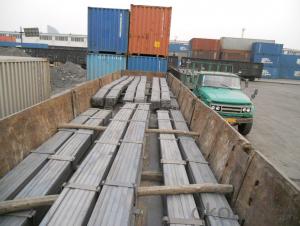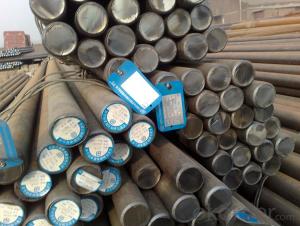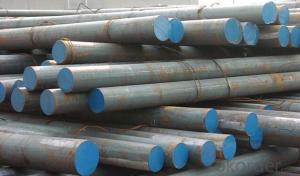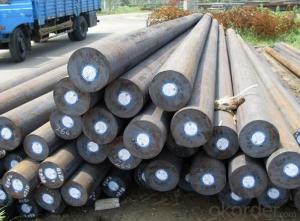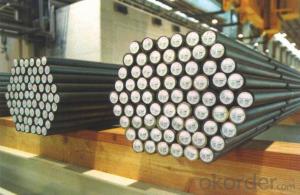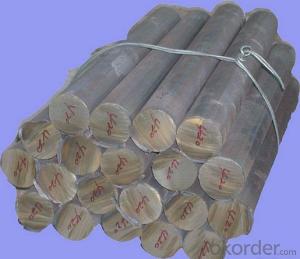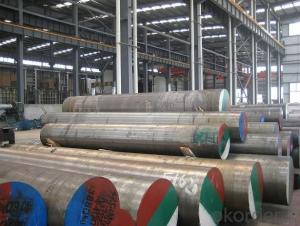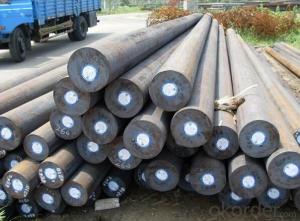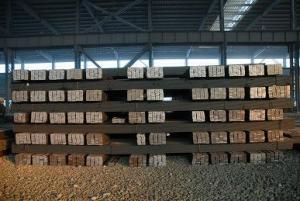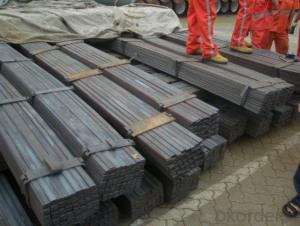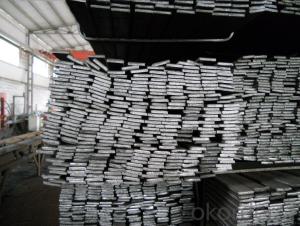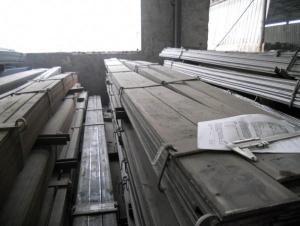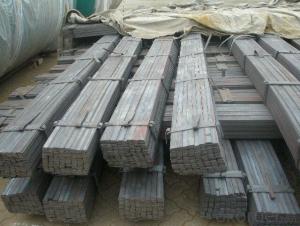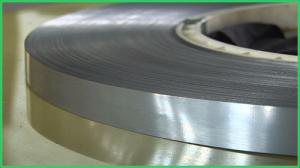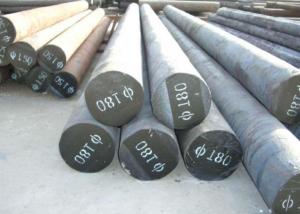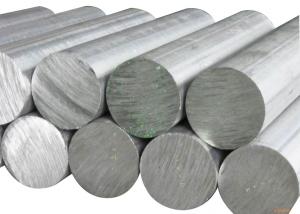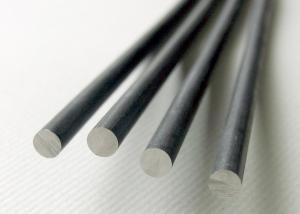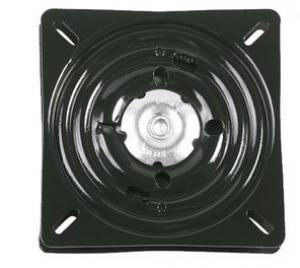Spring Steel Hot Rolled Flat Bar
- Loading Port:
- China Main Port
- Payment Terms:
- TT or LC
- Min Order Qty:
- -
- Supply Capability:
- -
OKorder Service Pledge
OKorder Financial Service
You Might Also Like
Product Description:
OKorder is offering high quality Steel Flat Bar at great prices with worldwide shipping. Our supplier is a world-class manufacturer of steel, with our products utilized the world over. OKorder annually supplies products to European, North American and Asian markets. We provide quotations within 24 hours of receiving an inquiry and guarantee competitive prices.
Product Applications:
Steel Flat Bar are ideal for structural applications and are widely used in the construction of buildings and bridges, and the manufacturing, petrochemical, and transportation industries.
Product Advantages:
OKorder's Steel Flat Bar are durable, strong, and resist corrosion.
Main Product Features:
· Premium quality
· Prompt delivery & seaworthy packing (30 days after receiving deposit)
· Corrosion resistance
· Can be recycled and reused
· Mill test certification
· Professional Service
· Competitive pricing
Product Specifications:
Commodity: Mild Steel Flat Bar
Standard: GB;JIS
Material: Q195-235;SS400
Origin place: China
Thickness: 3mm-30mm
Width:20mm-200mm
Length: Max 12m
Certification: SGS/BV

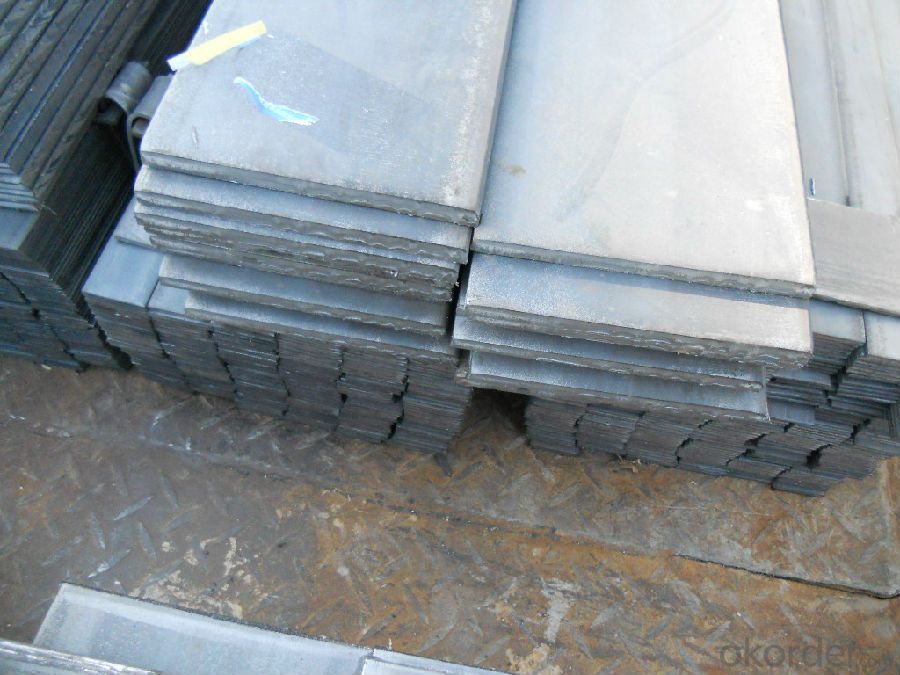
Usage/Applications of Steel Flat Bar
Widely used for construction, Machinery manufacturing, Iron tower steel structure, Shipbuilding; Steel grating, Staircase, Bridge, Viaduct, Railway spare parts, Boilers making etc.
Packaging & Delivery of Mild Steel Flat Bar
Packaging Details: The Mild Steel Flat Bars are packed in bundles and loaded in 20 feet/40 feet container, or shipped by bulk cargo ,also we can do as customer's requirements.
Delivery Details:30~45 days upon the receipt of buyer payment by T.T. or L/C.
Production Flow of Steel Flat Bar
The Mild steel flat bar is made through three processes:
1.Feeding the material: Feeding the row material (the steel plate) to Slitting Line.
2.Slitting:The steel plate would be slitted into expected width by lengthways cutter.
3. Leveled and cutting: The plat bar would be ground into level by the grinder and then cut into required length
FAQ:
Q1: Why buy Materials & Equipment from OKorder.com?
A1: All products offered byOKorder.com are carefully selected from China's most reliable manufacturing enterprises. Through its ISO certifications, OKorder.com adheres to the highest standards and a commitment to supply chain safety and customer satisfaction.
Q2: How do we guarantee the quality of our products?
A2: We have established an advanced quality management system which conducts strict quality tests at every step, from raw materials to the final product. At the same time, we provide extensive follow-up service assurances as required.
Q3: How soon can we receive the product after purchase?
A3: Within three days of placing an order, we will begin production. The specific shipping date is dependent upon international and government factors, but is typically 7 to 10 workdays.
Q4: What makes stainless steel stainless?
A4: Stainless steel must contain at least 10.5 % chromium. It is this element that reacts with the oxygen in the air to form a complex chrome-oxide surface layer that is invisible but strong enough to prevent further oxygen from "staining" (rusting) the surface. Higher levels of chromium and the addition of other alloying elements such as nickel and molybdenum enhance this surface layer and improve the corrosion resistance of the stainless material.
- Q: How does special steel perform in high-speed machining operations?
- Special steel is specifically designed to perform well in high-speed machining operations. It has unique properties that make it ideal for cutting, drilling, and shaping at high speeds. Firstly, special steel has excellent thermal conductivity, which means it can effectively dissipate heat generated during the machining process. This is crucial in high-speed operations as excessive heat can cause tool wear and deformation. By efficiently transferring heat away from the cutting edge, special steel helps to prolong tool life and maintain dimensional accuracy. Secondly, special steel has high hardness and strength, which allows it to withstand the intense forces and pressures encountered during high-speed machining. This enables it to maintain its shape and integrity, reducing the chances of tool breakage or deformation. Moreover, its high strength also ensures that the machined parts have excellent durability and resistance to wear. In addition, special steel exhibits good machinability, meaning it can be easily cut and shaped with minimal effort. Its composition and microstructure are optimized for efficient chip formation and removal, ensuring smooth operations and reducing the risk of chip clogging or tool jamming. Furthermore, special steel often contains alloying elements such as chromium, molybdenum, and vanadium, which enhance its resistance to corrosion and wear. This is particularly important in high-speed machining operations, where the cutting tools and workpiece are in constant contact. The improved corrosion and wear resistance of special steel contribute to longer tool life and improved surface finish. Overall, special steel is specifically engineered to excel in high-speed machining operations. Its thermal conductivity, hardness, strength, machinability, and resistance to corrosion and wear make it a preferred choice for applications that require fast and precise metal removal.
- Q: How does special steel contribute to the impact resistance of products?
- Special steel, also known as high-strength or high-performance steel, plays a crucial role in enhancing the impact resistance of various products. This type of steel is specifically designed to possess exceptional strength, toughness, and durability, making it highly resistant to deformation and fracture under high-stress conditions. One of the key factors that contribute to the impact resistance of special steel is its composition. Special steel often contains alloying elements such as manganese, chromium, nickel, molybdenum, and vanadium, which are incorporated to enhance its mechanical properties. These alloying elements provide the steel with increased hardness, tensile strength, and resistance to wear, corrosion, and fatigue. As a result, products made from special steel are capable of withstanding heavy impact loads without deforming or breaking. Furthermore, the microstructure of special steel plays a vital role in its impact resistance. Through advanced manufacturing techniques, the steel's microstructure can be fine-tuned to achieve a desirable combination of strength and toughness. Special heat treatment processes, such as quenching and tempering, can further refine the microstructure, resulting in a material that can absorb and dissipate energy more effectively. This makes special steel highly resistant to cracks and fractures, even when subjected to sudden and severe impacts. In addition to its intrinsic properties, special steel is often used in the form of engineered components or structures that are specifically designed for impact resistance. For example, in the automotive industry, special steel is utilized for manufacturing components like crash beams, bumpers, and roll cages. These components are designed to absorb and distribute impact energy, protecting the vehicle and its occupants during accidents. Overall, special steel significantly contributes to the impact resistance of products by providing superior strength, toughness, and durability. Its unique composition, microstructure, and design enable it to withstand high-stress conditions and absorb impact energy effectively. As a result, products made from special steel offer enhanced safety and reliability, making them suitable for a wide range of applications in industries such as automotive, aerospace, construction, and defense.
- Q: What is the importance of heat treatment in special steel?
- The significance of heat treatment in special steel cannot be emphasized enough as it greatly enhances its mechanical properties and overall performance. Special steel, also known as alloy steel, is specifically engineered to possess certain characteristics such as high strength, hardness, wear resistance, and toughness, making it suitable for challenging applications in industries like automotive, aerospace, and tooling. The process of heat treatment involves controlled heating and cooling of the steel in order to modify its microstructure, which subsequently impacts its properties. There are various heat treatment techniques employed, including annealing, tempering, quenching, and hardening, each serving a distinct purpose. One crucial aspect of heat treatment in special steel is its ability to enhance hardness. Through techniques like quenching and hardening, the steel can be transformed into a hardened state, making it significantly stronger and more resistant to abrasion and wear. This is of utmost importance for applications involving heavy loads, impact, and abrasive environments. Furthermore, heat treatment can also enhance the toughness and ductility of special steel. By precisely controlling the cooling rate during the heat treatment process, the microstructure of the steel can be adjusted to achieve a fine-grained structure, thereby improving its ability to withstand sudden impacts or shocks. This is particularly critical in applications where the material needs to absorb energy and resist fractures, such as in structural components or tools. Moreover, heat treatment can also improve the machinability and dimensional stability of special steel. By subjecting the steel to annealing or tempering processes, internal stresses and residual strains can be relieved, resulting in a more stable and easier-to-machine material. This is indispensable in industries where precision and dimensional accuracy are of utmost importance. In conclusion, the significance of heat treatment in special steel cannot be overstated. It is a vital process that enables the optimization of the steel's mechanical properties, ensuring that it fulfills the specific requirements of demanding applications. By skillfully manipulating the microstructure, heat treatment enhances the steel's hardness, toughness, and machinability, making it a versatile and dependable material in various industries.
- Q: What are the challenges in forging special steel?
- Forging special steel poses several challenges due to its unique composition and properties. Firstly, special steels often have high carbon content, making them harder to forge compared to lower carbon steels. The high carbon content increases the risk of cracking and requires careful temperature control during the forging process to prevent metallurgical issues. Secondly, special steels may contain alloying elements like chromium, molybdenum, or nickel, which enhance their specific properties. However, these alloying elements can also contribute to increased hardness and brittleness, making the forging process more challenging. Special attention must be given to heat treatment procedures to achieve the desired balance of strength and toughness. Furthermore, the complex internal structure of special steels, including the presence of inclusions and segregation, can further complicate the forging process. These internal defects can lead to uneven deformation, inadequate mechanical properties, or even failure during forging, necessitating meticulous quality control measures. Lastly, the cost of special steel materials is generally higher than that of regular steels, making any errors or wasted materials during the forging process more significant. The need for specialized equipment, skilled labor, and stringent quality assurance further adds to the challenges associated with forging special steel. Overall, forging special steel demands expertise, precision, and meticulous control of various parameters to ensure the desired mechanical properties and quality of the final product.
- Q: How does special steel contribute to the machinability of products?
- Special steel plays a significant role in enhancing the machinability of products. Machinability refers to the ease with which a material can be cut, drilled, or shaped using various machining processes. Special steel, also known as alloy steel, is specifically formulated to contain certain elements that improve its machinability characteristics. One key aspect of special steel that contributes to its enhanced machinability is its composition. By incorporating alloying elements such as manganese, sulfur, and phosphorus, special steel achieves improved machinability compared to regular carbon steel. These elements help in reducing friction during machining operations, resulting in reduced tool wear and extended tool life. Additionally, the presence of these elements facilitates the formation of smaller and more manageable chips during cutting, making it easier to control the machining process and maintain dimensional accuracy. Moreover, special steel often undergoes specific heat treatment processes, such as annealing or quenching and tempering, to further enhance its machinability. Heat treatment improves the steel's microstructure, making it more uniform and refined, which in turn improves its machinability characteristics. Heat-treated special steel exhibits better hardness, toughness, and resistance to wear, all of which are crucial for achieving high-quality machined products. Furthermore, special steel can be engineered to possess other desirable properties, such as high strength, corrosion resistance, or heat resistance, while still maintaining good machinability. This versatility allows manufacturers to select the most suitable special steel for their specific machining applications, ensuring optimal performance and productivity. In conclusion, special steel significantly contributes to the machinability of products due to its specific composition, heat treatment processes, and versatile properties. By utilizing special steel, manufacturers can achieve better machining performance, improved tool life, and higher dimensional accuracy, ultimately leading to superior quality products.
- Q: What is the role of boron in special steel alloys?
- Boron plays a crucial role in special steel alloys, particularly in enhancing their mechanical properties and overall performance. One of the primary functions of boron is as a hardenability agent, meaning it improves the hardness and strength of the steel. This is achieved through the formation of boride particles, which act as strengthening agents within the microstructure. Additionally, boron aids in the refinement of the grain structure of steel, resulting in improved toughness and resistance to cracking. It promotes the formation of fine-grained microstructures, which in turn increase the steel's ability to withstand high temperatures, pressure, and wear. Moreover, boron assists in the solidification process of steel, reducing the risk of hot cracking during casting or welding. It lowers the melting point of steel, allowing for better fluidity and improved flowability during manufacturing processes. Furthermore, boron can also enhance the machinability of steel alloys, making them easier to work with and reducing tool wear. Overall, the addition of boron to special steel alloys significantly contributes to their strength, hardness, toughness, and resistance to various forms of degradation. Its role is vital in optimizing the performance and durability of these alloys in demanding applications such as automotive components, aerospace structures, and industrial machinery.
- Q: What are the unique properties of stainless steel?
- Stainless steel possesses several unique properties that set it apart from other metals. Firstly, it is highly corrosion resistant, making it ideal for applications in environments with high moisture or chemical exposure. Secondly, stainless steel has excellent strength and durability, allowing it to withstand extreme temperatures and heavy loads. Additionally, it is hygienic and easy to clean, making it popular in industries such as food processing and medical equipment. Lastly, stainless steel is aesthetically pleasing, with a shiny and polished appearance that can be maintained over time.
- Q: What is the process of manufacturing special steel?
- The process of manufacturing special steel involves several steps. Firstly, raw materials such as iron ore, coal, and limestone are gathered and processed to create molten iron in a blast furnace. Next, impurities like carbon, sulfur, and phosphorus are removed through various refining techniques. Once the desired composition is achieved, the molten iron is transferred to a steelmaking furnace, where alloying elements like chromium, nickel, or manganese are added to impart specific properties. The mixture is then refined further to remove any remaining impurities and to adjust the temperature and composition. After refining, the molten steel is cast into various shapes such as blooms, billets, or slabs, depending on the desired end product. These primary forms are then subjected to hot rolling, forging, or extrusion processes to shape them into the desired final products, such as bars, plates, or wires. Finally, the manufactured steel undergoes heat treatment processes like annealing, quenching, or tempering to enhance its strength, hardness, and other mechanical properties. It is also subjected to quality control measures to ensure it meets the required specifications. Overall, the process of manufacturing special steel involves a combination of raw material preparation, refining, casting, shaping, heat treating, and quality control steps to produce steel with specific properties tailored to meet diverse industrial needs.
- Q: What are the different methods of surface grinding for special steel?
- For special steel, there exist numerous techniques for surface grinding. Presented below are some of the most commonly employed methods: 1. Blanchard Grinding: To eliminate material from the steel's surface, this technique employs a grinding wheel and a rotary table. The grinding wheel, usually composed of abrasive particles bonded together in a matrix, revolves at a high speed. Blanchard grinding excels in its ability to swiftly and efficiently remove substantial amounts of material, making it ideal for roughing operations. 2. Precision Grinding: This method is frequently utilized for finishing operations that demand a high level of accuracy and surface finish. Precision grinding entails the use of a surface grinder equipped with a fine-grit grinding wheel to eliminate a small quantity of material from the steel's surface. This process is typically slower and more precise than Blanchard grinding, resulting in a smoother and more refined surface. 3. Centerless Grinding: For cylindrical steel components necessitating exceptional precision, centerless grinding is commonly employed. This technique involves feeding the steel between a grinding wheel and a regulating wheel, with the grinding wheel removing material from the surface as it rotates. The regulating wheel governs the speed and feed rate of the steel, ensuring consistent and precise grinding. 4. Creep Feed Grinding: This technique is employed for the substantial removal of stock from large steel parts. Creep feed grinding involves employing a slow feed rate and making deep cuts to eliminate material from the surface. This method is typically employed for specialized applications where traditional surface grinding methods are unsuitable due to the size or complexity of the steel part. Ultimately, the selection of a surface grinding method for special steel hinges on factors such as the desired surface finish, accuracy requirements, and the size and complexity of the steel part. Consulting with a proficient grinding professional is vital to determine the most suitable method for a specific application.
- Q: What are the different additive manufacturing grades of special steel?
- There are several different additive manufacturing grades of special steel, including maraging steel, tool steel, stainless steel, and high-speed steel. These grades are specifically designed for additive manufacturing processes, offering enhanced properties such as high strength, corrosion resistance, and wear resistance.
Send your message to us
Spring Steel Hot Rolled Flat Bar
- Loading Port:
- China Main Port
- Payment Terms:
- TT or LC
- Min Order Qty:
- -
- Supply Capability:
- -
OKorder Service Pledge
OKorder Financial Service
Similar products
Hot products
Hot Searches
Related keywords
